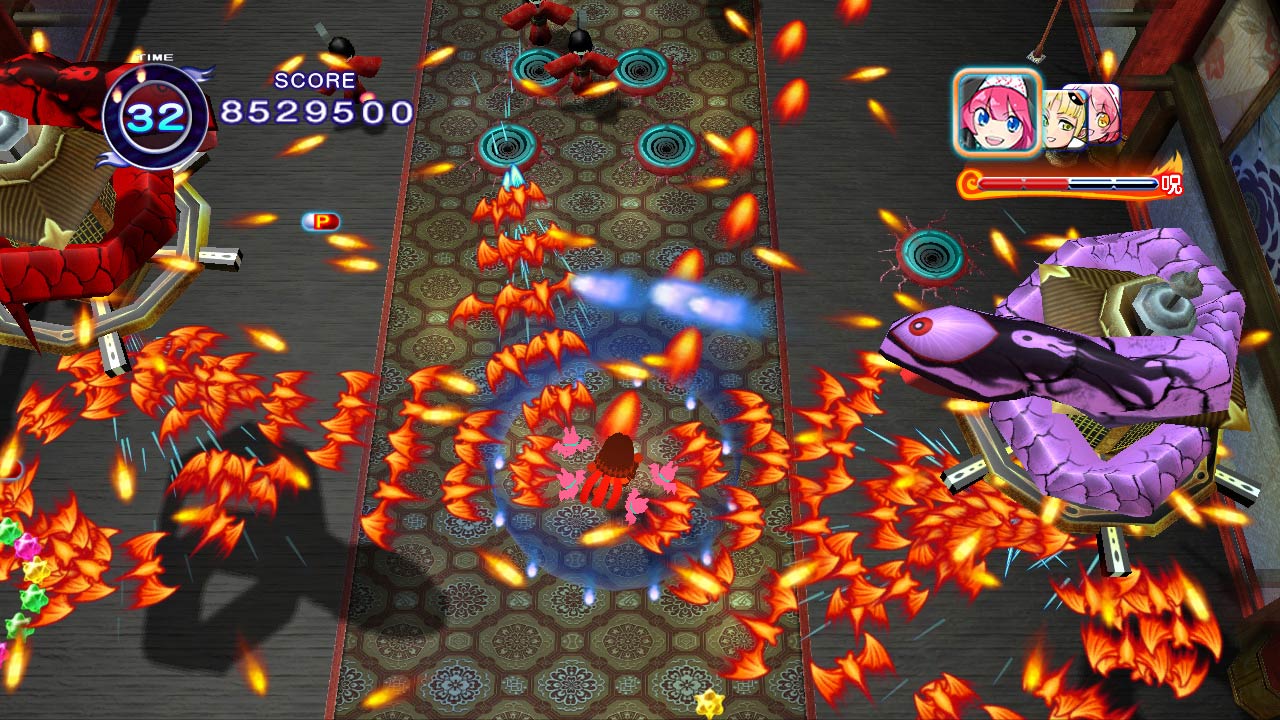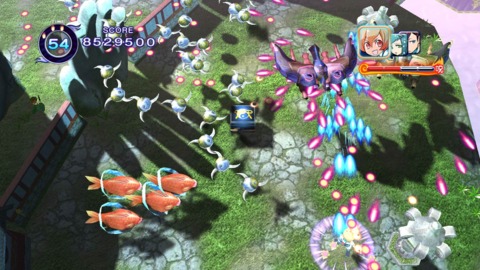When you think of classic arcade shoot-'em-ups, you probably think of spaceships or military vehicles blasting away grotesque alien scum and armored battalions. In recent years, however, many developers have taken the genre in a different aesthetic direction, with cute, colorful characters and projectiles replacing the aliens and gunmetal we traditionally associate with the shooter. Mamorukun Curse is one of only a handful of these recent shooters to see release outside of Japan, and it's a charming, challenging experience that overcomes a few off-putting visual issues.
Mamorukun Curse is an anime-inspired free-roaming shooter, similar in thematics and play style to Taito's old arcade game Kikikaikai (released on the SNES in the West as Pocky and Rocky). You select one of many cute, anime characters (or, in some modes, assemble a team of up to three or five characters) with varied types of fire (straight rapid fire, wide shots, homing, etc.) and hop into colorful stages filled with imagery of Japanese yokai and mysticism.

Your view doesn't automatically scroll in most stages, as it would in shooters like Gradius; instead, you are given free movement to run around the top-down-view levels and aim your fire in any direction you please. To facilitate better aiming and movement, you can swap controls between single-analog/D-pad control, where the character aims in the direction you move unless you are holding down the fire button, or dual-stick control (one analog for movement, and one for aiming). Both schemes have advantages: the dual-stick control makes fast aiming and taking out enemies easier, but is much less precise for dodging enemy bullets.
Mamorukun's more unique control addition, however, is the multi-purpose curse button. Most shooters tend to have a limited-use smart bomb that eliminates all enemy fire and causes huge damage to anything onscreen. The curse button expands on this concept by encompassing multiple functions. By pressing the button, enemy fire will instantly disappear from the screen. Holding the button charges up a curse gauge, and releasing after charging sends out a powerful shot that destroys small enemies instantly and creates a cursed field when it hits larger foes. Foes affected by the cursed field slow down, take constant damage during the few seconds that the field is active, and when defeated, yield a huge amount of candy-colored bonus gems. However, these enemies also gain a slight power boost, firing faster, more abundant shots. Also, as long as the field is active, you can't use the fire-negating option.

Giving the curse button a quicker press, rather than holding it down, creates a small cursed field that your character can hop into for a temporary power boost, granting them a few precious seconds of immensely damaging and increased-range firepower. Once your self-curse wears off, however, you must wait for a cooldown period before using any functions of the curse button again. The self-curse also doesn't provide total invincibility: you can still take damage from enemy fire despite your power boost. Learning the ways to use curses on enemies and yourself is both fun and challenging, and some stages force you to use the curses in interesting ways, such as a trap-filled castle with invincible spinning blades you must curse to slow down and weave through. Learning how to utilize cursing to beat the game is one thing, but if you're keen to dominate the leaderboards, you'll find that using curses wisely increases scoring potential.
You're going to need to get your shooting and cursing skills down to a science, too. The cute anime artwork and bright colors betray a game that can be extremely challenging, with some of the higher-difficulty bosses and settings delivering volleys of fire straight out of bullet hell. The game is tough at first, but as you discover what characters and curses are capable of, you'll enjoy the satisfaction of growing more and more skilled with replays. Different gameplay modes vary the challenges somewhat. Netherworld Adventures gives you teams of three characters to complete single stages under a time limit: if one character falls, the next takes their place. Arcade mode, a straight port of the game's original Japanese arcade release, also features a time limit to keep you from dawdling too much. It challenges you to complete a set of levels you pick out with a single character in under five minutes, with bonus time awarded for each stage cleared and continues available when you lose all your health.
Story mode is probably the central draw of Mamorukun Curse, however. The game follows the wacky manga-style misadventures of Mamoru and the other characters that are somehow stuck in the netherworld with friendly spirits haunting each of them. You are given five characters to complete the story mode with: when one falls, the next takes their place, and when all five are gone, it's game over. You can only revive characters by collecting life hearts in stages--characters don't revive between levels at all--so it's crucial to keep as many characters alive as possible for the difficult later levels. There are some irritations, however: the story is utterly incoherent nonsense for the most part, and if you get a game over in this mode, you're thrown back to the mode select screen rather than given a retry option, forcing you to mash start to skip through story bits and try again.

As fun as Mamorukun is, its dated graphics and a few puzzling issues impact the fun. Most of the character models would have looked embarrassingly simple on the Dreamcast, much less on the PlayStation 3. Characters and environmental objects clip into each other constantly, perhaps most obviously on the water level atop a giant floating stingray. The colorful nature of the art design is pleasant, but sometimes it can interfere with gameplay, as enemy bullets and bonus gems can look very similar at a glance. One level has flower blossoms constantly blowing across the screen that exacerbate this issue, though thankfully, they go away after a while.
Taken as a whole, however, Mamorukun is a prime example of how niche genres that have fallen out of mass popularity continue to transform and evolve. The cursing of yourself and foes adds a fantastic element of strategy and skill to a game that is otherwise pretty straightforward, making the experience considerably more engaging and fun in the process. The varied modes and challenging difficulty, along with the ease of hopping into Netherworld Adventures or Arcade mode, make Mamorukun Curse easy to pick up and play when you want a quick, skillful, rainbow-colored adrenaline rush.
'